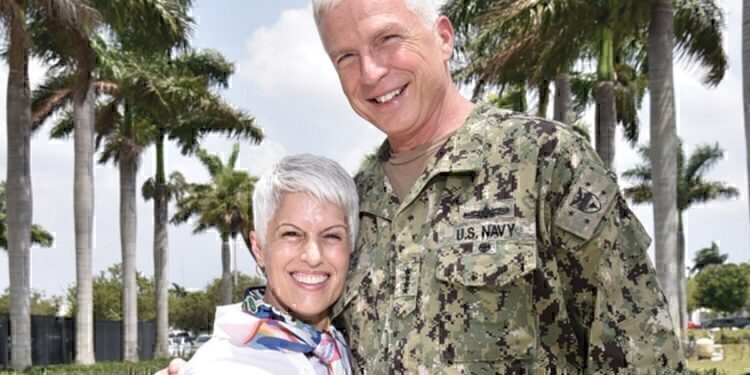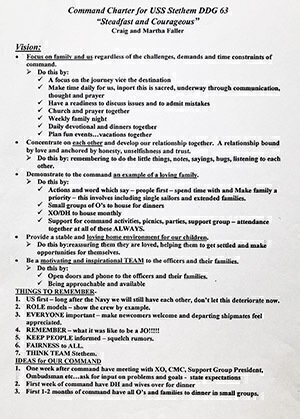Our guide to keep us on course no matter what storm comes our way.
By ADM Craig and Martha Faller
We want to highlight the benefit of developing a Command Charter to provide service members and their spouses with both a course and a compass throughout life and their military career. We use the charter as a centering tool to challenge assumptions, stimulate a desire to keep learning, and assist when sailing in troubled waters.
Click on the video below to view the Keynote from the May G.I. Jobs Virtual Career Expo where Adm. Craig and Martha Faller talk through the Command Charter and the importance of it in their lives.

We have a saying that “our spouses serve too,” and we know that military families would agree. Their voluntary service and support are essential. We want to share our story of how we developed and adapted our original charter to help keep us on course while serving our team at United States Southern Command (SOUTHCOM).
More than 20 years ago, we attended the Navy’s Command Leadership Course in Newport, R.I., in preparation for our first command tour on USS STETHEM (DDG 63). There, we were challenged to create our own Command Charter – a set of values, ideas, and principles to keep accessible and refer back to often throughout our tour. This “tool” is meant as an ever-present reminder of what we value both individually and as a couple. It is our guide to keep us on course no matter what storm comes our way.
After all these years, and 25 moves, we still know where to find our original copy. We deliberately create routines and physical encounters to ensure we review and reflect on our charter. During Command tours on STETHEM, SHILOH, Navy Recruiting, Carrier Strike Group Three and now at SOUTHCOM, we have hung it in prominent and often intrusive places, such as in front of our shared shoe rack in the master bedroom closet. Martha keeps a copy in her Bible.
She says, “I enjoy reading and reflecting every morning, looking at our charter as part of that reflection time.”
Fast forward to October 2018. Following Craig’s confirmation by the US Senate as the next commander of SOUTHCOM, we decided to update our charter and found that most of what we had written was still applicable. We focused on each other, made the charter shorter, and emphasized the value of time.
Enter SOUTHCOM and the global pandemic. What do you do when there is no script, no relevant lessons learned or examples to follow? We asked ourselves, “What are our first principles of life and leadership, and how do we apply these leading through the pandemic?” We returned to our values and beliefs as captured in our Command Charter.
We knew we needed to build trust with our team quickly—communicating to our workforce and their families that we had a plan to keep them safe.
Inspired by our own charter, we came up with Pandemic Principles for our Command Family.
We wanted the Command Family to know that we get it, and we care. We have to walk the talk associated with our principles. To help us lead in the pandemic we derived two key principles from our Command Charter: (1) Keep everyone informed and together and (2) Build trust.
Keep everyone informed and together
Whatever communications methods we were using, we enhanced them and doubled down on questioning our effectiveness. This approach involved more telephone calls to find out how teammates were doing, maximizing all means of virtually connecting, and increasing—not decreasing—walks about the Command to check on people to ensure the many “new” rules associated with pandemic safety were being applied.
We believe that as leaders, if you assume you are communicating effectively, then you are already sliding backward into communication oblivion. We are as imperfect as any couple, but we find that truly trying to put ourselves in other’s shoes provides us empathy to handle challenges. The pandemic has greatly altered many important elements of life. Dealing with people with empathy is key. This starts by asking questions and listening to the answer, then taking action. Our thumb rule is: repeat everything eight or more times by every method available and then constantly challenge our own effectiveness. We tried to be empathetic, available and creative.
Martha wanted to devise a creative way to reach out to spouses and family members. She writes: “I decided to make a daily video to share with our command families. This daily connection was under 2 minutes…just a little “hello” to hear a friendly voice, feel connected, and learn what I was doing each day. Some days I shared what I learned while walking and listening to my podcasts. As time passed, I wondered how long I would be able to come up with enough interesting and captivating segments. For the sake of my listeners, I decided to have an “end” date for my daily connection. I was born in 1962 so I decided I would share 62 video connections. I looked forward to “connecting” through this platform. What started as an attempt to reach out and help others ended up providing an additional daily purpose and focus for the first 62 days of this pandemic.”
Build trust – start by looking in the mirror and asking, “Who trusts me?”
We recognize that trust is the glue that holds a team together, and it must be earned. As our charter asks, “Do people trust us?” It’s not about us. It’s about the team.
As we share our experience, we encourage any spouse or teammate who identifies with our experience to embrace learning opportunities. Seek out resources that will help to keep your sight on the “big picture,” your feet on the path that you and your spouse have chosen, and remind you to find purpose in every day. Cultivating our lives today as good stewards of our purpose, will positively change who we become tomorrow.
We know our beliefs have helped guide us – beliefs developed by observing servant leadership from mentors, peers and others in command leadership positions, and by serving our nation. We are glad we wrote it down and studied our own playbook—our Command Charter. We wanted to share our experience and charter in hope that it may help you.
ADM Craig Faller is commander of US Southern Command.









